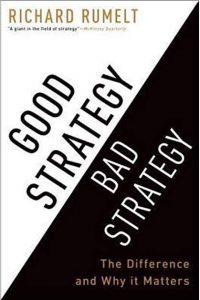Startup Strategy Right Actions at the Right Time
Startup Strategy is a subject much written about. Many business school professors and strategy consultants like Bain, BCG and McKinsey have built their reputations based on their own models of business strategy.
Personally, I am not a slave to one model or another. Michael Porter, and his Five Forces of Competitive Advantage, is perhaps the most widely cited authority. His hugely significant recent thinking has concerned the concept of building Shared Value. Its focus is on the connections between societal and economic progress, rather than what otherwise seems to be self-interest. This approach makes good sense for those committed to building a sustainable and beneficial business.
The best recent thinking and writing, in my opinion though, is by Richard Rumelt who has been teaching strategy
at UCLA for many years. His book is called, Good Strategy Bad Strategy: The Difference and Why It Matters. Rumelt’s model was central to my own MBA teaching on sustainable strategy. Students still learned about other approaches so that they could have the best tools at their disposal.
Kernel of Strategy
I like Rumelt’s book because not only is he widely experienced and has worked with many companies on their strategy. He tells many strategy stories from real life and describes his own deceptively simple model to help you understand how to craft your own startup strategy.
Rumelt says the “kernel” of a strategy contains three elements: diagnosis, guiding policy, and coherent actions:
- Diagnosis defines or explains the nature of the challenge. Good diagnosis simplifies the often overwhelming complexity of reality by identifying certain aspects of the situation as critical.
-
Guiding policy deals with the challenge. This is an overall approach chosen to cope with or overcome the obstacles identified in the diagnosis.
-
Coherent actions are designed to carry out the guiding policy. These are steps that are coordinated with one another to work together in accomplishing guiding policy.
Startup Strategy
Startup strategy has some significant differences to business strategy in general. Too many entrepreneurs try to aim at positive cash flow, sustainable growth, and profitability—right from Day One. This is not a good startup strategy. Using bravado will not cut it. On the other hand, being overcautious doesn’t work either.
The beginning founder does have to be concerned with all three financial measures—cash, growth, and profit, to survive. However, initially founders must stay alive and that’s why cash in the bank is so critical. Without it, no business will survive. Chances are high that your learning curve will be steep, especially in matters of finance.
Cash Flow
Startup Strategy often leaves out the question of how it will have the right amount of cash to keep the business running.
About a third of small businesses fail because they run out of cash. This often happens because founders are a) not measuring and forecasting cash flow and b) rushing to focus on profit too early. There are many other reasons for this.
First among them is that their product does not meet a real customer demand. The second comes from not having the right people. One of my two co-founders, for example, decided that the entrepreneurial life was not for him. So he returned to the corporate world within a few months of startup.
The third contributor to cash problems relates to cost/pricing issues. User un-friendly products and an ignorance of customer needs will also contribute to the early end of a startup.
In any case, the new business may not have the right amount of finance available. Notice that I say the right amount. It should neither too much and encourage profligacy, nor too little and create penny pinching. The startup may not be on top of income in a way that will dictate how startup strategy needs to be tweaked.
Customer Relationships
In my own main business, started in 1982, the base of our startup strategy was built upon the premise that we needed to continually refine our understanding of how our product could meet customer demand. We had three decent contracts signed up on Day One, because we had been testing the product before that. Our policy kept us very close to our customers and we learned from them. At the end of the first year, for example, we set up User Conferences.
We measured several customer related financial numbers, including order intake and sales forecasts. We did not use surveys to keep close to the customers. Our startup strategy style was to spend time with them—and always to listen attentively. In fact we built customer relationships.
Right Startup Strategy at the Right Time
In the first year or two, the startup strategy, should focus should on customers and cash to build the company’s strength (see Customer Lifetime Model). Then, when it looks as though the business will survive, the startup strategy can shift focus to growth. At this stage profits are nice, but still not necessary.
In the third stage of startup development, while not dropping the emphasis of customers, cash and growth, more effort will naturally go to profit. Think about it!
Timetable of Startup Strategy
|
1. Pre-Launch: Identify Best Customers
1 Use Business Model Canvas & Business Model Planner; 2 Use Value Proposition Canvas; 3 Get Founders Stay Afloat: by tracking 25 vital facts & figures |
|
2. From Day One: Go for Cash Flow
1 Get Founders Stay Afloat: by tracking 25 vital facts & figures; 2 Use Lean Startup: the principles are Build—Measure—Learn…action |
|
3. Once Positive Cash Flow is Regular: Go for Growth
|
|
4. When Growth is Reliable: Go for Profit
|






